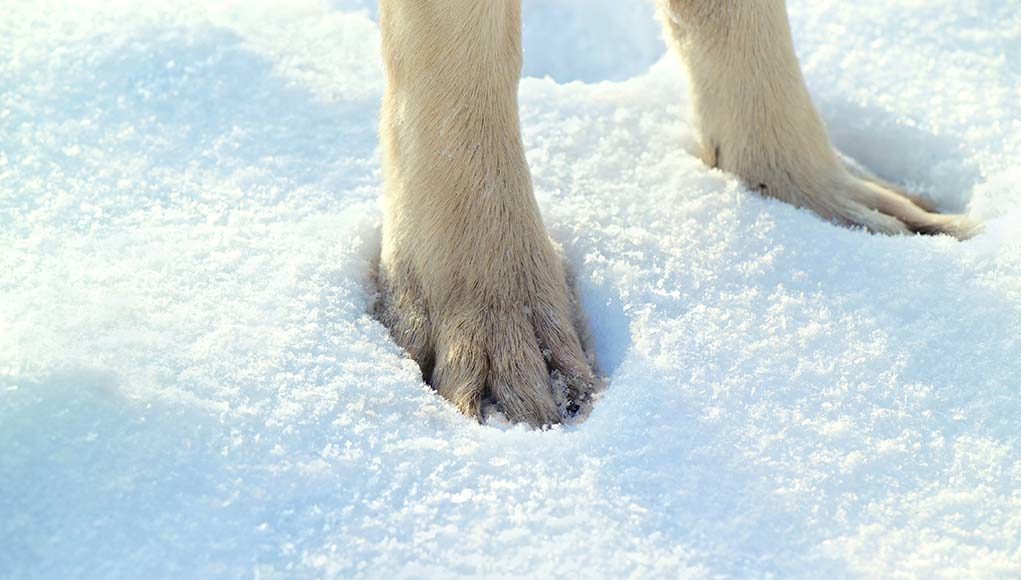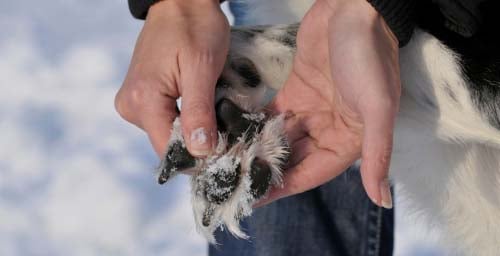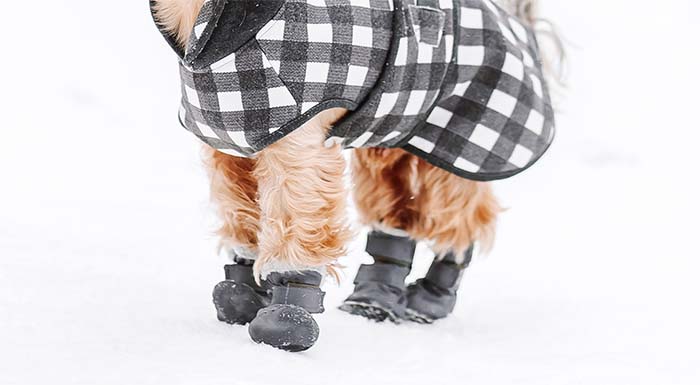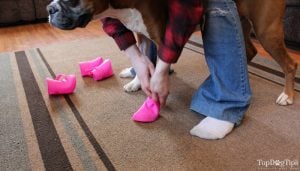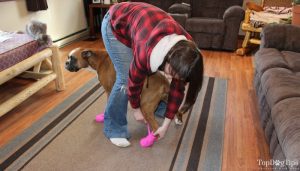Dogs' paws are more utilitarian than our feet – they're designed to withstand frigid conditions, such as ice and snow. The paw pads act as insulated snow boots. The thick outer skin, fatty tissue, and intricate vein networks mitigate cold weather, keeping the paws safe from the dangers of freezing temperatures.
Dog paw protection is needed only in rare circumstances, because each paw acts as its own cooling and heating regulator. A circulatory system processes the cold temperatures from the ground, warming the blood then spreading it through the dog's body. This contribution of warm blood helps to maintain a safe core temperature.
However, despite this superior circulatory system, extended or frequent time spent outdoors in cold weather can eat away at your dog's otherwise healthy paws, which means you need to find ways of protecting dog paws in winter.
The Biggest Danger to Your Dog's Paws
The real culprit of degrading paw healthiness during winter is not cold weather, ice or snow, but rather chemical de-icing fluids and products littering the ground. Even some of the most safe and pet-friendly ice melts can be dangerous for the dog.
Anti-ice salts are toxic to dogs and can cause adverse reactions on the skin, intoxication when consumed (occurring when a dog grooms their paws by licking or gnawing). A paw may also scrape over sharp shards of ice or de-icing salt, creating an open wound that’s painful, difficult to heal, and highly prone to infection.
Luckily, you can avoid your dog's paw degradation during winter using a combination of below tips on protecting dog paws in winter and a few dog paw protection products.
5 Ways of Protecting Dog Paws in Winter
1. Know Your Pet’s Cold Tolerance
Frigid temperatures for double-coated, large, adult, healthy, and active dogs isn't something to worry about, but for older, smaller, thinly-coated dogs or those suffering from medical conditions (e.g. arthritis), the cold weather may be problematic.
Breeds like Siberian Husky, Bernese Mountain Dog, or Akita have higher tolerance for cold weather than Chihuahuas or Basenjis, both of which hail from desert, arid regions. Similarly, dogs with little to no fur, such as Chinese Crested, sleek Greyhounds, and skeletal Whippets have more difficulty in snow and freezing rain.
It’s easy to tell a dog's cold-tolerance from their demeanor while outdoors. They’re likely to express them being cold by tucking their tail, shivering, and refusing to go outside. Pulled back ears and a low, slow wagging tail can also represent anxiety and/or a sense of being unsure about the cold temperatures.
Pay attention to your dog's nonverbal tell-tale signs like these when outside in winter.
2. Alter Your Walking Routine
During the winter, the sun sets earlier, giving our days less sunlight and less warmth. One way of protecting dog paws from problems in winter is to walk your pet during the warmer hours of the day rather than early in the morning or late at night.
If the schedule allows, anticipate the weather. If it’s supposed to start sleeting at 10 AM, plan the outdoors time for earlier in the morning to get ahead of inclement weather.
Keep the walks shorter. For small breeds, it's under 15 minutes for temperatures below 30 degrees Fahrenheit. For healthy double-coated dogs, limit walks and playtime to 15-20 minutes when temperatures drop below 20 degrees Fahrenheit.
Note that temperatures are worsened when moisture and/or wind are present. A good rule is to deduct 5 to 10 degrees from what your weather resource reports for each additional element (be it ice, rain, or harsh, fast winds).
3. Routinely Monitor the Paws
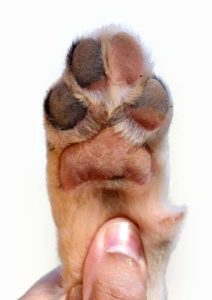 While it’s unlikely your dog’s paws are severely suffering from winter exposure, it's common for paw pad skin to begin to dry out and crack. In moderation, this is simply normal, but without care, cracked paws can lead to infections and discomfort.
While it’s unlikely your dog’s paws are severely suffering from winter exposure, it's common for paw pad skin to begin to dry out and crack. In moderation, this is simply normal, but without care, cracked paws can lead to infections and discomfort.
You can buy dog paw creams, lotions and moisturizers for a daily dog paw protection routine. They keep paws hydrated and moist, preventing cracking and splitting.
Another danger in the winter are sharp objects hidden under blankets of snow. Routinely monitor the paws as foreign debris may become lodged in between toes where the skin is vulnerable, resulting not only in discomfort but bruises and infections.
4. Alter Your Pet’s Home Life
Dogs who spend more time outside in cold weather should be fed slightly more. Their bodies are working overtime to keep warm, burning more calories.
Your front or back door should become a paw-wiping stations. Keep a dog paw wash and a towel by the door for when you come back inside. More for keeping the place keep, consider using a dog doormat to prevent messes in the house.
Dogs are sensitive about their paws. When washing them, use verbal affirmations and praise. Eventually, this will become routine, and your dog may start lifting their paw up for you, especially when prompted verbally or with a soft graze of your hand.
5. Alter the Grooming Routine
It’s never recommended to shave double coated dogs, but trimming any low-hanging trundles or strands is a good idea – these are most vulnerable to collecting moisture and ice. Also, trim hair on dog's paws and in between their toes before winter sets in.
Ensure your pet’s nails are clipped to an appropriate length. Overgrown nails reduce a dog’s ability to be stable on slippery surfaces such as ice.
Allowing a dog’s hair to grow thick and long will keep them warmer, but you need to brush it regularly. Matted fur lays too close and thick to the skin, reducing the body’s ability to regulate its temperature and exposing the dog to more dangers.
Consistent grooming will help spread the natural oils through a dog's fur, providing further overall body and dog paw protection.
3 Best Dog Paw Protection Products for Winter
As far as protecting dog paws in winter goes, there are two most common products (1) paw balms that act as “shields” when applied, and (2) dog shoes or socks, sometimes called booties, which are worn. You need to use only one of these at a time.
1. Paw Balms and Waxes
Protective paw balms and paw waxes (applied before a walk) are not the same as moisturizing lotions mentioned above (applied after a walk, at home).
Paw balms/waxes are popular in regions with harsh winters. These topical creams do a great job of protecting paw pads from de-icing salts that cover the sidewalks after an ice storm of snowfall. These products also contain skin-soothing elements to help keep paws from hyperkeratosis and becoming cracked.
Paw balms and topical creams utilize non-toxic and non-allergenic ingredients, so even if a dog licks at their paws, they’ll stay safe. Wax-based balms also act as anti-slip topical solutions, helping dogs keep their grip on slippery surfaces where it’s hard to find traction.
2. Natural Homemade Paw Balms
Even if the above products are completely natural and safe, you can take it a step further and choose to make your own homemade stuff. It's easy and ingredients aren’t difficult to find. You only need a pot to boil the contents together.
A simple homemade dog paw balm recipe:
- 2 tablespoons coconut oil
- 1 tablespoon shea, mango, or avocado butter
- 4 teaspoons unscented beeswax
- 2 tablespoons olive or grape seed oil (note: while grapes are toxic to dogs, this seed-based oil is safe)
This simple DIY dog balm can be stored and used for up to 2 years. Its benefits aren’t limited to just one season out of the year. You’ll find the tackiness of the wax and the moisturizing qualities of the oils help your dog's paws stay healthy while walking on hot pavement during the summer, too.
3. Dog Booties or Socks
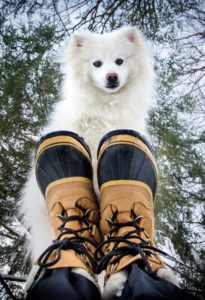 Balms and waxes can get messy and it takes more time to put them on, and then wash them off. Dog shoes may be a more convenient solution, but not all dogs like them.
Balms and waxes can get messy and it takes more time to put them on, and then wash them off. Dog shoes may be a more convenient solution, but not all dogs like them.
Alternatively, you can pick up dog socks – your pet may be more open to wearing them and some can be warmer. The downside is they don't provide much traction or protection as dog booties.
The benefits of wearing dog paw protection gear is that there's no need to clean the paws off afterwards, no need to worry about any harmful snow-deterrent chemicals eating away at paw skin or getting eaten, no need to wonder if sharp ice or objects have become lodged. Overall, dog booties are one of the best ways of protecting dog paws in winter, and some are made for winter time specifically.
How to Put Dog Booties On Your Pet
Small breeds are more tolerant of wearing shoes; most dogs don't like them. But any dog can be trained to accept wearing booties, just as they were trained to accept their leash, or harness.
On average, a dog will get used to dog booties in about 5 days, but proper introduction is crucial. Don’t put all four booties on all four paws all at once. This will be overwhelming, and your pet is likely to stop trusting you, making the process harder in the future.
Use a treat that is motivating to your pooch (ideally, something they rarely eat, like shredded chicken, cut up hot dogs, or bacon). The more exciting and delicious the treat, the more likely they’re to come around to the idea of wearing dog boots.
There's a full guide on how to put on dog shoes, but it all boils down to these five steps:
1. Introduce the shoes. Show your pup the booties with an outstretched hand. When they sniff at them or walk in their direction, give them several treats. Do this a few times throughout a day, until they begin to associate the very presence of the booties with a delicious treat and praise from you.
2. Touch your dog’s paws. This is important sensitivity training you should begin when they’re a puppy as it makes vet and grooming visits much more pleasant and easy going. Many animals feel very vulnerable when their paws are touched and so spending some time getting your pet familiar with the sensation of being touched there will benefit the both of you. At first, only touch a paw for a couple of seconds and always follow up with a treat. Build up the time. After working on the front two paws, move on to the back two. The back two paws are typically more sensitive, and dogs are generally more protective of these, thus extra patience may be needed when maneuvering sensitivity training here.
3. Touch the boots to the dog’s paw. Treat them when they see you have the booties and treat them immediately following it being touched to their paw. Some dogs may pull their paw away from it; that’s okay, they still deserve a treat. Slowly but surely, you’re conditioning them to associate the boots with positivity.
4. Start very slowly. For a few seconds only, put one bootie on a front paw, without fastening it. Quickly take the bootie off and treat your pet. If they instantly protest to this, try not to become frustrated. They’re telling you the process is moving a little too fast for them, in which case your response should be moving back a step and working on that for more time. If your dog is ready for this step, repeat it over the course of the day in short intervals. This will keep them from feeling overwhelmed and you from feeling impatient. Once your dog is okay with the booties being on their front two paws, follow these same steps with the back two paws.
5. Put them on. 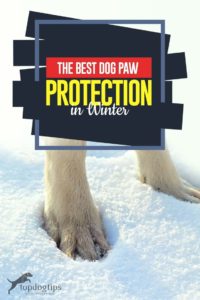 The final step is to put all four booties on at once and slowly make it a routine. Your dog is likely to look a lot more like a new-born fawn in their initial, awkward steps, but they will grow used to it. Let your dog become more accustomed to their new fashion statement in the comfort of your home or backyard before taking them on a walk or excursion in the snow. Once they walk relatively well in them and respond appropriately when you get them out to be put on, they’re ready to enjoy a frolic in the snow.
The final step is to put all four booties on at once and slowly make it a routine. Your dog is likely to look a lot more like a new-born fawn in their initial, awkward steps, but they will grow used to it. Let your dog become more accustomed to their new fashion statement in the comfort of your home or backyard before taking them on a walk or excursion in the snow. Once they walk relatively well in them and respond appropriately when you get them out to be put on, they’re ready to enjoy a frolic in the snow.
With the above tips on protecting dog paws in winter, and using any of the dog paw protection gear (balms/waxes, booties, etc.) you'll be ready to go into the harsh winter weather without repercussions that may cost more if you fail to prevent injuries, infections, dry skin, or hyperkeratosis.
READ NEXT: The 5 Best Remedies for Dog’s Dry or Itchy Skin, Paws and Nose


